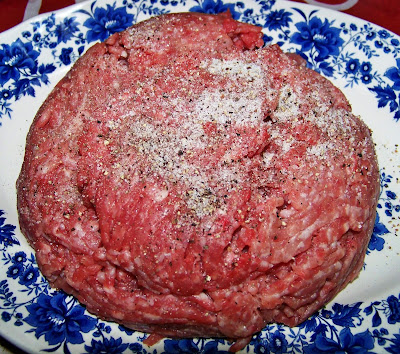Although I am not much of a carnivore, I do sometimes eat beef and pork (especially jamón ibérico). One day while looking at recipes I saw a recipe for meatballs that caught my eye. I actually kept my readers in mind because I realized that until then I had not made a single dish with beef or pork. I stumbled across a recipe for "Albóndigas a la Madrileña", or Madrid style meatballs. These meatballs are the typical meatballs seen in Spanish tapas bars; the dry, cold meatballs taking a bath, accompanied by peas, in a gravy-like sauce in a tray beneath the glass display counter on the bar are later warmed up in a microwave upon request of the patron.
Those meatballs I referred to are actually a tradition in many Spanish houses, and every Spaniard will tell you that his/her mother's version is the best. So, having a recipe in hand, and many Spaniards to consult for advice, I created my own version. I went to my local market to get fresh meat and vegetables for the dish. Going to a local market is always an adventure for me, so I try to go regularly both to support local business and chat with the locals.
I went first to the butcher where we struck up a conversation on the seasons, he said that winter was the best for carniceros, Spanish for butcher. While there, he told me about his version of meatballs, telling me how much beef and pork I needed and exactly how to cook them. This action evoked a spirited group of 70ish year old Spanish women, who all had their own ways to make "Spanish meatballs". A trip to the greengrocer and 20 recipes later I was finally home with the ingredients and forced to draw up a new plan for my version of albóndigas.
The Spanish word for meatball, albóndiga, comes from Classic Arabic bunduqah, which comes from the Ancient Greek κάρυον ποντικόν, meaning hazelnut. The meatballs I make do resemble a large hazelnut, but taste much different. They are a mix of 3/4 beef and 1/4 pork, Italian parsley, garlic, onions, eggs, and flour. The meatballs just wouldn't be meatballs if it weren't for the sauce that accompanies them. I make the sauce using carrots, peas, leeks, onions, garlic, and sherry. Combined with the sauce they make a perfect meal any time of the year. So even if it is summer time, give your butcher some business and make some Spanish meatballs.
This dish is one that can easily be made in any part of the States any time of the year. In fact, I made it a few times when visiting my family and I have to say that it was my most successful dish. You could serve this dish with mashed potatoes, rice, or bread. The most common accompaniment in Spain is bread. I encourage you to experiment with the dish and serve it how you want. I hope you, your family, and your friends enjoy my take on Spanish meatballs!
Equipment
Chopping board
Chopping knife
Vegetable peeler
Large pot
Frying pan
Wooden spoon
Bowls
Plates
Whisk
Ingredients
4 cloves of garlic
 2 medium onions
2 medium onions1 large leek
8 medium carrots
2 tomatoes
1/2 lb of fresh or frozen peas
1 1/2 lbs of ground beef
1/2 lb of ground pork
2 eggs
1 glass of sherry
Olive oil
Flour
Salt
Pepper
Cumin
Handful of Italian Parsley
Fresh rosemary
Fresh thyme
Bay leaf
Instructions
1. Finely chop one onion, two cloves of garlic, and the parsley. Mix the ground beef, ground pork, salt, pepper, and cumin.
2. Mix the chopped ingredients with the meat. Then add two beaten eggs.
4. Brown the meatballs in the skillet. (It is not necessary to fully cook them at this point.) Set them aside and reserve oil and drippings.
5. Finely chop the other onion, garlic, leeks, and carrots. Peel, seed, and dice the tomatoes.(Refer to photos.)
6. Heat the oil and drippings in a large pot. Add the onions and cook for a minute.
7. Add the carrots and the bay leaf. Cook for 5 minutes.
8. Add the leeks and cook for 5 minutes.
9. Incorporate the tomatoes, garlic, cumin, and fresh herbs. Cook for 5 more minutes.
10. Pour in the glass of sherry and allow to reduce a few minutes.
11. Put the peas in along with two cups of water. Let cook a few minutes.
12. Add the meatballs and a bit more water, just enough to almost cover the meatballs.
13. Cover the pot and reduce heat to low. Let cook for about an hour. (Check the meatballs occasionally and stir, but don't do it too often because it should be cooking on low heat.)
14. If you see that the sauce seems a bit too liquid, sift some flour into the mixture to thicken it a bit.
15. When you have a thick sauce and the meatballs seem nice and tender, it is time to eat! I hope you enjoy!




























































